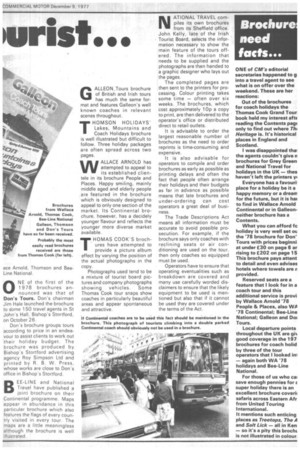First catch your .
Page 58

Page 59

If you've noticed an error in this article please click here to report it so we can fix it.
)URS BROCHURES these days no longer seem to come in any shapes and sizes: many of them — expensive colour bs though they are — also resemble each other side. This, I think, is a pity. A tours brochure yes a coach company its first and vital chance I get its personality over to its potential istomers: that it cares, is flamboyant — or, as the Ise may be, specialises in restful tours — takes care ith attention to detail, can be trusted and has nnpetitive prices, writes Noel Muffler.
But whatever types of tours a offered, the brochure's first 3 is to attract the client who ]lks into the travel agent or the ioking office. Brochures are formative advertising and ust do a -hard-selljob.
Secondly, they must give ospective clients the inforation they require without ;in their attention and before ey reach the section that par:ularly interests them.
The third job is to dose the le, and provide the means for tually booking the tour — a ioking form and phone imber. The brochures must: • Show where and how the tour will be carried out.
• Give information that will attract passengers.
• Illustrate the coaches to he used at their most photogenic.
• Inform customers of the places to be visited, and the service provided — in a way that will attract passengers while not being totally unrepresentative.
All the brochures I have seen tend to supply too much information and the pages of conditions in particular become an effort to read. I am sure many clients will just skip through them. The brochures use colour great extent and often achie somewhat over-powering off Extra blue skies and seas I just a little beyond the realm reality and meaningless pict appear in abundance.
Operators, whether larg small, who operate inclu tours, usually first arrange information to be presente the public by contacting an vertising or design agency.
The design agency takes information and organises it a package that will look attractive as possible.
Particular care should taken to ensure that,wh coaches and hotels are used i brochure photographs coaches are the most up to possible.
Of the brochures that I h seen so far this year some h come from actual co operators and some from pur tour operators.
Brochures have bee, received this month from pr. vate operators Don's Tours c Bishop's Stortforcl, Herts, Gali eon Tours, Thomas Cook, Wal
ace Arnold, Thomson and BeeLine National.
0 NE of the first of the 1978 brochures announced was that of Don's Tours. Don's chairman Jim Hale launched the brochure to some 150 travel agents in St John's Hall, Bishop's Stortford, on October 26.
Don's brochure groups tours according to price in an endeavour to assist clients to work out their holiday budget. The brochure was produced by Bishop's Stortford advertising agency Roy Simpson Ltd and printed by R. B. W. Press, whose works are close to Don's office in Bishop's Stortford.
BEE-LINE and National Tra\cel have published a joint brochure on their Continental programme. Maps appear in abundance in this particular brochure which also features the flags of every country visited in every tour, The maps are a little meaningless although the brochure is well illustrated.
ALLEON..Tours brochure of British and Irish tours has much the same format and features Galleon's well known coaches in relevant scenes throughout.
HOMSON HOLIDAYS' Lakes, Mountains and Coach Holidays brochure is well illustrated but difficult to follow. Three holiday packages are often spreadacross two pages.
WALLACE ARNOLD has attempted to appeal to its established clientele in its brochure People and Places. Happy smiling, mainly middle aged and elderly people are featured in the brochure which is obviously designed to. appeal to only one section of the market. Its Continental brochure, however, has a decidely younger flavour and reflects the younger more diverse market available. T, HOMAS COOK'S brochures have attempted to provide a picture album effect by varying the position of the actual photographs in the copy.
Photographs used tend to be a mixture of tourist board pictures and company photographs showing vehicles. Some Thomas Cook tour snaps show coaches in particularly beautiful areas and appear spontaneous and attractive.
NATIONAL TRAVEL cornpiles its own brochures from its Sheffield office. John Kelly, late of the Irish Tourist Board, selects the information necessary to show the main feature of the tours offered. The information that needs to be supplied and the photographs are then handed to a graphic designer who lays out the pages.
The completed pages are then sent to the printers for processing. Colour printing takes some time — often over six weeks. The brochures, which cost approximately 10p a copy to print, are then delivered to the operator's office or distributed direct to retail outlets.
It is advisable to order the largest reasonable number of brochures as the need to order reprints is time-consuming and expensive.
It is also advisable for operators to compile and order brochures as early as possible as printing delays and often the fact that people often arrange their holidays and their budgets as far in advance as possible means that late brochures and under-ordering can cost operators a great deal of business.
The Trade Descriptions Act means all information must be accurate to avoid possible prosecution. For example, if the brochure says only coaches with reclining seats or air conditioning are used on the tour, then only coaches so equipped must be used.
Operators have to ensure that operating eventualities such as breakdown are covered and many use carefully worded disclaimers to ensure that the likely equipment to be used is mentioned but also that if it cannot be used they are covered under the terms of the Act.




































































































